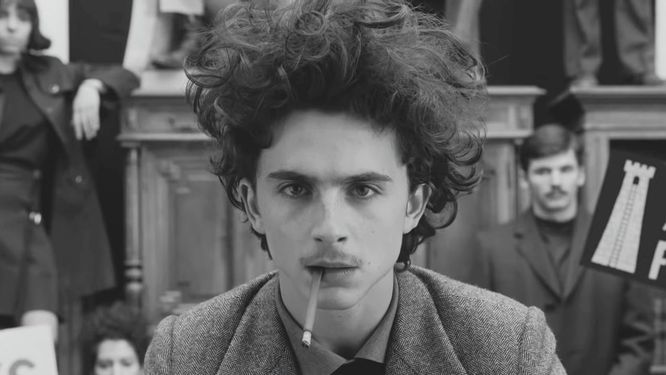“The French Dispatch” uses nostalgic whimsy to spread the joy of stories and storytellers
Timothée Chalamet stars in “The French Dispatch,” a love letter to journalists and the power of journalism.
November 19, 2021
There is a very specific feeling you get when watching a Wes Anderson movie. A certain nostalgia pervades his projects, giving all his work a familiar glow. Unlike most, the dreamy nostalgia he seeks to show on film is not a reverence for things in his own youth, but rather for the fantasies of ages past. As Anderson attempts to capture some ethereal magic from the wistful nature of his mind, he reaches for the stylings and imagery of some older grandeur. For instance, through his films “The Grand Budapest Hotel,” “Moonrise Kingdom” and “The Darjeeling Limited,” one can easily identify a romanticization of the past, portrayed through beautiful colors, camera tricks, detailed sets and calculated framing. All this adds up to a certain tangible nature, where viewers can almost touch the past.
His films have often been compared to dioramas for their visual intricacy and careful composition, as well as their physicality. Though nothing in his film is realistic, there is a realism that is carried through by the seemingly-tactile nature of the worlds Anderson creates. The objects in his films, from the outfits to the architecture to the props, ground the films, while still being distinctly from an older age. The aesthetics and physicality of times that never actually existed carry through, creating an impressionistic longing for the past, even though they are far from accurate representations. The framing, visual symmetry and deliberate use of fanciful physical objects make his films living paintings, with each frame bursting with vibrancy and sentimentality.
Anderson’s latest film, “The French Dispatch,” released this past October, pushes this concept even further. A love letter to journalism, but unlike other such films that extoll the virtues of the industry as a whole, such as “All the President’s Men” and “Spotlight,” this film commemorates a specific type of journalism—the 20th century print magazine. Centering on the titular “French Dispatch” magazine, based in the fictional French town, Ennui-sur-Blasé, the film showcases the tales of the journalists that work there relaying stories to the public at large. Calling back to the heyday of “The New Yorker” through aesthetics and style, the film also tries to emulate the feeling of reading one of those magazines.
The film itself becomes an issue of the magazine, taking on an anthological format to tell the stories within. At the center of the film is the editor of the magazine, Arthur Howitzer Jr. (Bill Murray), who works to put together each issue by compiling stories from his writers. Each correspondent narrates their story with varying senses of intrigue and importance, but all impart life lessons along the way. The four stories are of varying quality, I suppose like a real magazine, but the eccentric writers who deliver them, and the slices of life that they each reveal, make them all worthwhile. Owen Wilson whimsically muses while riding around the town of Ennui on his bicycle. Tilda Swinton delivers the tale of a homicidal yet brilliant artist (Benicio Del Toro) in love with his own prison guard (Léa Seydoux). Lucinda Krementz (Frances McDormand) relays her experience with student revolutionaries and her affair with their leader (Timothée Chalamet). Roebuck Wright (Jeffrey Wright) narrates from memory his experience of eating dinner with the police commissioner as his son is being kidnapped. Each character delivers their own message, leaving watchers with the satisfaction of having enjoyed another thrilling story from a distance. Through this, the joy found from perusing “The New Yorker” is crystallized in its purest form and in a way that could only be done by Wes Anderson.
It is once again the details that make this film sell the concept. Each story bursts with the love of print as they integrate various stylistic elements: Anderson’s trademark use of colors, the integration of text, the use of graphics and animations, along with visual puns and slick transitions. The heart found within, however, is ultimately what makes this film what it is. “The French Dispatch” is enjoyable for its clear love of physical aesthetics, from food to design to clothing to architecture. Enwrapped in this endearing world, though, are tales of love, thoughtfulness, loyalty, folly and decency. It is a movie filled with an appreciation for physical beauty, but also the beauty within every person’s tale. Just as the writers at “The French Dispatch” cobble together tales of the human experience, the film celebrates the story within us all and the people who shine a spotlight on them.



